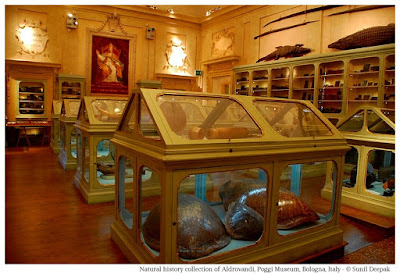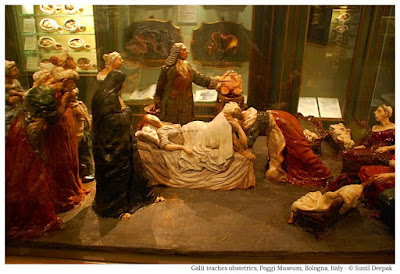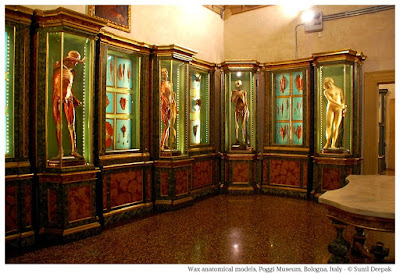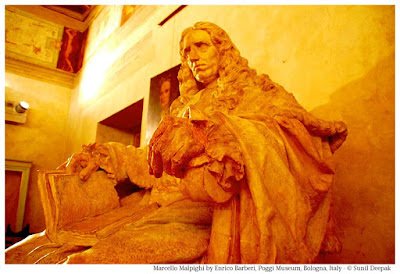However, this museum is not just about babies in the womb, it also has many other important exhibits related to scientific discoveries in the 16th -19th centuries. This post will introduce you to this beautiful museum.
Bologna has one of the oldest universities in Europe, it started in 1088 and was part of that era which led to Enlightenment and Renaissance periods. During these, persons started looking at critically and exploring their surroundings, from natural phenomenon to rocks and minerals to plants and animals. Rationalism became the key word and people started questioning the religious dogmas.
Bologna had a number of noblemen (and a few noble women, though their work has not been documented equally well) who did pioneering work in the scientific enquiry. Ulisse Androvandi born in Bologna in 1522 was one such pioneer, whose work on natural history led to a private collection of objects, that became the core of the Science museum of Palazzo Poggi in the 20th century (Image below: the Aldrovandi room.
Story of the Odysseus
The hall near the entrance, now used for meetings and events, shows beautiful paintings of the artist Pellegrino Tibaldi depicting the episodes from the life of Odysseus (Ulysses in Latin), the Greek king of Ithaca and the hero of Homer's epic poem The Odyssey.
Babies in the womb exhibits
This is my favourite part of the museum. The use of three dimensional models to teach the complexities of child birth to future obstetricians was started in Bologna by Prof. Giovanni Antonio Galli in the 18th century (image below). His teaching was so good that a school of obstetrics was created here in 1758.
Doctors like Prof Galli employed their own sculptors and artists to make the human body models to teach to the students. Ercole Lelli was appointed as the head of this department of scientific artists. In 1742, Lelli proposed the creation of human sized statues of men and women to explain the different layers of muscles and bones. Thus the anatomy room was created in Poggi Palace in 1747.
The museum also hosts a copy of a famous female body model called "Medici's Venus" (the name referred to the Medici family of Florence as well as to doctors) created in Florence by the artist Clemente Susini around 1780. In this model, the students could open the different parts of the female body and understand how different organs were placed inside and their inter-relationships, including the pregnant uterus. The model was useful for surgery students to see the blood supply and nerves around the different organs and plan their surgery.
The museum is full of exhibits from Bologna, each of which has its own importance in the history of science in the world. It has equipment that was used to make important scientific discoveries. I just want to share two examples with you.
The first example is of Marcelo Malpighi, called the father of microscopic anatomy, histology, physiology and embryology. He pioneered the use of microscope to understand the human and animal bodies. For example, he was the first person to see the capillaries and explain how arteries and veins connected and their role in blood circulation. His name is remembered in "Malpighian" bodies.
Conclusions
The science museum of Palazzo Poggi in Bologna is a treasure trove if you are interested in the history of medicine and use of art for teaching science. In this post, I have limited myself to certain parts of this museum. However, the museum has many more things to show, such as the development of war strategies and the ship-building.
***





















No comments:
Post a Comment
Thanks for visiting Arre Kya Baat Hai and for your comment! Please use a civilised language. Comments with embedded links are removed.